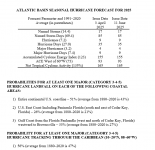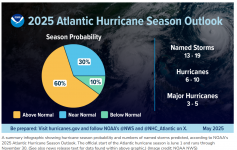Well, this post on the coming tropical season in the Atlantic Basin is a little late, as I usually send these out in mid-June, but I’ve been busy having fun and goofing off instead. Anyway, CSU's and NOAA's 2025 Atlantic Basin Tropical Activity Predictions, which are both for “above average” levels of activity, are below, including some discussion. Will keep track of the seasonal count in this thread (3 weak TS's so far) and will start separate threads on any significant storms.
The forecasts from both Colorado State University (CSU, where the late Dr. Gray pioneered seasonal predictions, which are much more accurate than random guessing) and the National Oceanic and Atmospheric Administration (NOAA) have been for a busy season since early spring and now that the tropical season has officially started, the latest updates (5/22 from NOAA and 6/11 from CSU) from the two major sources continue to predict an active tropical season for the Atlantic Basin; see the links and graphics below. Also, note that the 3rd link, below, has a summary of predictions from about 20 different sources, with all of them predicting a moderately above normal season.
CSU's prediction is for 17 named storms (vs. the 30-year average of 14.4), 9 hurricanes (7.2 avg) and 4 major hurricanes (3.2 avg), while NOAA's forecast is very similar to CSU's, with predictions of 13-19 (mean of 16) named storms, of which 6-10 (mean of 8) are expected to become hurricanes, including 3-5 (mean of 4) major hurricanes; see the graphics and links below. These predictions from both CSU and NOAA are a bit above normal for tropical storms, hurricanes and major hurricanes, although not “way above” normal. It’s also worth noting that CSU includes a prediction of ACE, or the Accumulated Cyclone Energy Index for the all of the storms in the seaons, which is also decently above normal at 155 vs. 123 for a typical season.
However, note that whether a tropical season is considered above or below normal or just normal, what's most important, usually, is landfalling hurricanes, especially major ones (or ones with extraordinary rainfall), which is why last year's very active season wasn't particularly impactful, as only Idalia made US landfall as a major hurricane (and fortunately in the sparsely populated Big Bend area of Florida); similarly, in a below normal or normal year, all it takes is one monster, catastrophic landfalling storm, like Ian a couple of years ago, to make a season impactful. On the other hand, a season full of small, weak systems without major landfalls would not be considered that “bad” which is what we’ve had so far this season with 3 short-lived, weak tropical storms.
Also, as an FYI, last year’s forecasts by both CSU and NOAA were for an extremely active tropical season and we ended up with 18 named storms (14.4 avg), 11 hurricanes (7.2 avg) and 5 major hurricanes (3.2 avg), all of which are well above average and would mean the seasonal forecasts from most sources, like CSU and NOAA were reasonably accurate, despite the slow start to the season. CSU predicted 23 named storms, 11 hurricanes and 5 major hurricanes, so they were a bit low on named storms, but spot-on for hurricanes and major hurricanes, which most would argue are more important. And NOAA predicted 21 named storms, 10.5 hurricanes and 5.5 major hurricanes, which is also quite close to actual.
Both CSU and NOAA use much of the same combination of analog-based forecasts (looking back at key tropical indicators, like El Nino and tropical Atlantic sea surface temps (SSTs) for past seasons with similar indicators) and forward-looking dynamical/statistical global weather models. Both cite the ENSO (El Nino/Southern Oscillation indicator) state with its generally expected neutral conditions, i.e., there will likely be neither El Nino (warmer than normal equatorial Pacific Ccean temps) nor La Nina conditions (cooler than normal equatorial Pacific Ocean temps), which usually means more tropical activity, due to lowered wind shear over the Atlantic Basin, and they also cite the current and expected warmer-than-normal subtropical Atlantic SSTs (which also usually means more tropical activity and the potential for more powerful storms, as hurricanes use warmer waters as "fuel" for intensification) as keys to their forecasts.
We'll see soon, but keep in mind that the CSU group, in particular, has been far more accurate (near 70%) with their above normal, normal, below normal predictions than simple climatological guessing would be (1 in 3, on average, if guessing). Let's see how it all goes, but the predictions are a bit concerning, especially for coastal communities in the Gulf of Mexico, the US (and Canada) East Coast, and the Caribbean.
https://tropical.colostate.edu/forecasting.html
https://www.noaa.gov/.../noaa-predicts-above-normal-2025...
https://seasonalhurricanepredictions.org/.../seasonal...


The forecasts from both Colorado State University (CSU, where the late Dr. Gray pioneered seasonal predictions, which are much more accurate than random guessing) and the National Oceanic and Atmospheric Administration (NOAA) have been for a busy season since early spring and now that the tropical season has officially started, the latest updates (5/22 from NOAA and 6/11 from CSU) from the two major sources continue to predict an active tropical season for the Atlantic Basin; see the links and graphics below. Also, note that the 3rd link, below, has a summary of predictions from about 20 different sources, with all of them predicting a moderately above normal season.
CSU's prediction is for 17 named storms (vs. the 30-year average of 14.4), 9 hurricanes (7.2 avg) and 4 major hurricanes (3.2 avg), while NOAA's forecast is very similar to CSU's, with predictions of 13-19 (mean of 16) named storms, of which 6-10 (mean of 8) are expected to become hurricanes, including 3-5 (mean of 4) major hurricanes; see the graphics and links below. These predictions from both CSU and NOAA are a bit above normal for tropical storms, hurricanes and major hurricanes, although not “way above” normal. It’s also worth noting that CSU includes a prediction of ACE, or the Accumulated Cyclone Energy Index for the all of the storms in the seaons, which is also decently above normal at 155 vs. 123 for a typical season.
However, note that whether a tropical season is considered above or below normal or just normal, what's most important, usually, is landfalling hurricanes, especially major ones (or ones with extraordinary rainfall), which is why last year's very active season wasn't particularly impactful, as only Idalia made US landfall as a major hurricane (and fortunately in the sparsely populated Big Bend area of Florida); similarly, in a below normal or normal year, all it takes is one monster, catastrophic landfalling storm, like Ian a couple of years ago, to make a season impactful. On the other hand, a season full of small, weak systems without major landfalls would not be considered that “bad” which is what we’ve had so far this season with 3 short-lived, weak tropical storms.
Also, as an FYI, last year’s forecasts by both CSU and NOAA were for an extremely active tropical season and we ended up with 18 named storms (14.4 avg), 11 hurricanes (7.2 avg) and 5 major hurricanes (3.2 avg), all of which are well above average and would mean the seasonal forecasts from most sources, like CSU and NOAA were reasonably accurate, despite the slow start to the season. CSU predicted 23 named storms, 11 hurricanes and 5 major hurricanes, so they were a bit low on named storms, but spot-on for hurricanes and major hurricanes, which most would argue are more important. And NOAA predicted 21 named storms, 10.5 hurricanes and 5.5 major hurricanes, which is also quite close to actual.
Both CSU and NOAA use much of the same combination of analog-based forecasts (looking back at key tropical indicators, like El Nino and tropical Atlantic sea surface temps (SSTs) for past seasons with similar indicators) and forward-looking dynamical/statistical global weather models. Both cite the ENSO (El Nino/Southern Oscillation indicator) state with its generally expected neutral conditions, i.e., there will likely be neither El Nino (warmer than normal equatorial Pacific Ccean temps) nor La Nina conditions (cooler than normal equatorial Pacific Ocean temps), which usually means more tropical activity, due to lowered wind shear over the Atlantic Basin, and they also cite the current and expected warmer-than-normal subtropical Atlantic SSTs (which also usually means more tropical activity and the potential for more powerful storms, as hurricanes use warmer waters as "fuel" for intensification) as keys to their forecasts.
We'll see soon, but keep in mind that the CSU group, in particular, has been far more accurate (near 70%) with their above normal, normal, below normal predictions than simple climatological guessing would be (1 in 3, on average, if guessing). Let's see how it all goes, but the predictions are a bit concerning, especially for coastal communities in the Gulf of Mexico, the US (and Canada) East Coast, and the Caribbean.
https://tropical.colostate.edu/forecasting.html
https://www.noaa.gov/.../noaa-predicts-above-normal-2025...
https://seasonalhurricanepredictions.org/.../seasonal...

